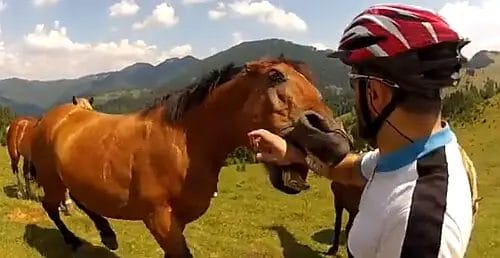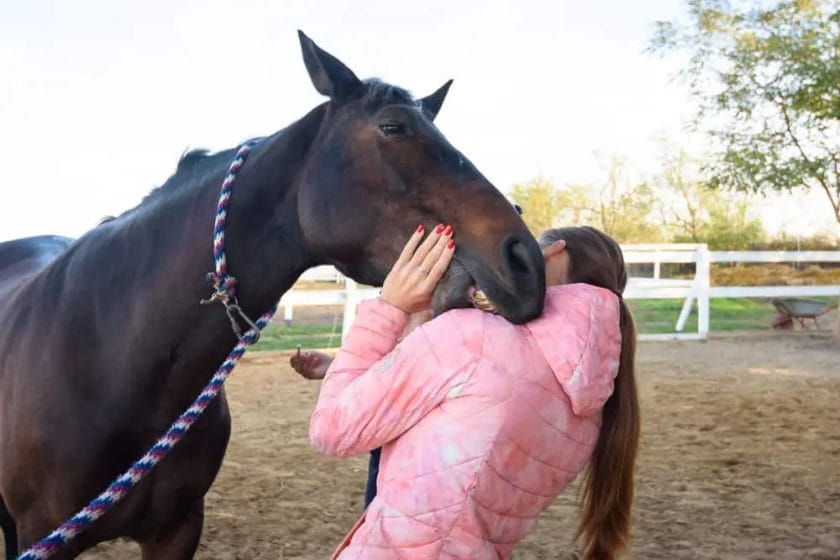Horses biting other horses is a natural behavior that can occur due to a variety of reasons. It is often seen during social interactions or when horses establish their hierarchy within a herd. Biting can also be a sign of dominance, frustration, or even playful behavior. Understanding the underlying causes and addressing them is crucial to maintaining harmonious relationships among horses and ensuring their well-being. Proper training, socialization, and providing sufficient space and resources can help minimize biting incidents and promote a peaceful equine environment.

Factors Influencing Horse Biting: Dominance, Territory, and Resources
Understanding the factors that influence horse biting is essential for horse owners and trainers. Biting behavior in horses can have various underlying causes, including dominance, territory, and resources. By examining these factors, we can gain insights into the reasons behind this behavior and develop effective strategies to address it.
Dominance
Horses are social animals that establish hierarchies within their herd. Dominance is an important factor that can contribute to biting behavior. In a herd setting, horses will assert their dominance through various behaviors, including biting. This behavior is often seen when a horse wants to establish its position in the hierarchy or challenge another horse’s dominance.
To address biting behavior related to dominance, it is important to establish a clear hierarchy within the horse’s environment. Consistent and fair training techniques, combined with appropriate socialization, can help establish boundaries and reduce aggressive behaviors.
Territory
Horses are territorial animals and may bite to defend their space. This behavior is often observed when another horse or human encroaches upon their perceived territory. Biting in such cases is a defensive response aimed at protecting their personal space.
To address biting related to territorial behavior, it is important to establish clear boundaries and teach horses appropriate personal space. Consistent training and positive reinforcement can help horses understand boundaries and reduce territorial aggression.
Resources
Competition over limited resources can also lead to biting behavior in horses. This includes resources such as food, water, and shelter. Horses may resort to biting as a means to gain access to these resources or establish dominance over other horses in the herd.
To address biting behavior related to resource competition, it is important to provide ample resources for all horses in the herd and minimize competition. This can be done by ensuring that each horse has access to sufficient food, water, and shelter. Additionally, implementing a structured feeding routine and using feeders that promote individual access can help reduce resource-related biting behavior.
Summary
In summary, several factors can influence horse biting behavior. Dominance, territory, and resource competition are three key factors that can contribute to this behavior. Understanding these factors and implementing appropriate training and management strategies can help address and minimize biting behavior in horses. By providing a safe and well-structured environment, horse owners and trainers can create a harmonious atmosphere where biting becomes less prevalent.

Aggression in Horses: Causes and Prevention of Biting
Horses are generally gentle and sociable creatures, but just like any other animal, they can exhibit aggressive behavior. One common form of aggression in horses is biting. Biting can be both dangerous and disruptive, posing a risk to both humans and other horses. To understand and effectively address this issue, it is important to explore the causes of aggression in horses and implement appropriate prevention strategies.
Causes of Aggression in Horses
There are several factors that can contribute to a horse’s aggressive behavior, leading them to resort to biting. Here are some common causes:
- Pain or discomfort: Horses may bite as a response to physical pain or discomfort. It could be due to an underlying medical condition, ill-fitting equipment such as saddles or bridles, or even dental problems.
- Protecting resources: Horses are territorial animals and may bite to protect their food, water, or personal space. This aggression can be directed towards other horses, humans, or even other animals.
- Frustration or fear: Horses can act out aggressively when they feel frustrated or fearful. This could be a result of inadequate training, a stressful environment, or past traumatic experiences.
- Social hierarchy: In a herd setting, horses establish a social hierarchy where dominance and submission play a crucial role. Aggression, including biting, can occur when a horse tries to assert or maintain its position in the pecking order.
Prevention of Biting
Addressing and preventing biting behavior in horses requires a combination of understanding their needs and implementing appropriate strategies. Here are some preventive measures that can help:
- Regular veterinary care: Ensure that your horse receives regular check-ups to identify and address any underlying health issues that may contribute to aggressive behavior, such as dental problems or pain.
- Proper training and socialization: Invest time and effort in training your horse using positive reinforcement techniques. This will not only establish boundaries but also build trust and confidence, reducing the likelihood of aggressiveness.
- Consistent and clear communication: Use consistent cues and signals to communicate with your horse effectively. Clear and assertive communication helps establish your role as the leader and reduces confusion or frustration.
- Adequate exercise and mental stimulation: Ensure that your horse receives regular exercise and has access to a stimulating and enriching environment. Boredom and pent-up energy can contribute to aggressive behavior.
- Safe and appropriate social interactions: When introducing your horse to other horses or animals, carefully monitor the interactions and intervene if any aggressive behavior is displayed. Gradually introduce new companions and provide ample space for each horse to establish their personal boundaries.
- Use of protective gear: In cases where biting poses a serious risk, the use of appropriate protective gear, such as a muzzle, can help prevent injuries to both humans and other animals.
In summary, aggression in horses, particularly biting, can be caused by various factors such as pain, resource protection, fear, and social hierarchy. Understanding these causes and implementing preventive measures, including regular veterinary care, proper training, consistent communication, exercise, and safe social interactions, can help mitigate aggressive behavior and promote a harmonious relationship between horses, humans, and other animals.

4. Handling Horse Biting: Training and Behavioral Modification Techniques
Horse biting can be a frustrating and potentially dangerous issue to deal with. It is important to address this behavior promptly to prevent any harm to both the horse and the people handling it. In this section, we will discuss effective training and behavioral modification techniques to handle horse biting.
Understanding the Reason Behind Biting
Before diving into training techniques, it is crucial to understand why a horse bites in the first place. Biting can stem from various reasons, including:
- Pain or discomfort
- Frustration or anxiety
- Protecting their territory or resources
- Lack of proper training or socialization
- Aggression towards other horses or humans
By identifying the root cause of the biting behavior, you can tailor the training approach accordingly.
Establishing Boundaries and Consistency
Consistency is key when addressing horse biting. It is important to establish clear boundaries and rules for the horse to follow. When handling a horse, ensure that you are consistent in your reactions to their behavior. Here are some steps to follow:
- Set clear boundaries and expectations for the horse’s behavior.
- Be firm but fair in your corrections. Use clear and consistent cues to communicate with the horse.
- Reinforce positive behavior by rewarding the horse with praise or treats when they exhibit appropriate behavior.
- Avoid reacting aggressively or using excessive force, as this may escalate the biting behavior and lead to further issues.
Redirecting and Distracting the Horse
When a horse attempts to bite, it is important to redirect their attention and provide an alternative behavior. This helps in teaching the horse that biting is unacceptable. Here are some techniques to try:
- Immediately redirect the horse’s focus by asking them to perform a specific command, such as moving their feet or focusing on a particular task.
- Use positive reinforcement techniques to reward the horse when they respond appropriately to redirection.
- Provide the horse with appropriate chew toys or treats to redirect their biting behavior towards more acceptable objects.
- Consistently reinforce the desired behavior and discourage biting through redirection and positive reinforcement.
Seek Professional Help
If you are unable to address the biting behavior on your own or if it persists despite your efforts, it may be beneficial to seek assistance from a professional horse trainer or behaviorist. These experts have the knowledge and experience to evaluate the situation and provide specialized training techniques to modify the horse’s behavior.
In summary, handling horse biting requires a combination of training techniques and understanding the underlying cause of the behavior. By establishing boundaries, providing consistent and fair corrections, redirecting the horse’s attention, and seeking professional help if needed, you can effectively address and modify biting behavior in horses. Remember, safety should always be a priority when working with horses, so approach the training process with patience and caution.
Ensuring Equine Welfare: Creating a Safe and Harmonious Herd Environment
Creating a safe and harmonious herd environment is essential for ensuring the welfare of your equine companions. Horses are highly social animals that thrive in a natural herd setting. To promote their well-being, it is important to establish a secure and peaceful environment where they can interact with each other in a positive manner. In this section, we will discuss key considerations and strategies for creating a safe and harmonious herd environment for your horses.
1. Adequate Space and Facilities
One of the fundamental aspects of ensuring equine welfare in a herd environment is providing sufficient space and facilities. Horses are large animals that require ample room to move, graze, and engage in natural behaviors. Ideally, each horse should have access to at least one acre of land in a pasture setting. This allows them to exercise and socialize comfortably.
In addition to space, the availability of shelter is crucial for protecting horses from extreme weather conditions such as excessive heat, cold, or rain. Adequate shelter can be in the form of well-constructed run-in sheds or stables, ensuring that horses have a safe place to seek refuge from the elements.
2. Balanced Herd Dynamics
Establishing a balanced herd dynamic is essential to promote a harmonious environment among the horses. It is important to consider the personalities, temperaments, and age groups of the horses when forming a herd. Introducing new members gradually and monitoring their interactions can help prevent conflicts and ensure a smooth integration process.
Monitoring the herd dynamics on an ongoing basis is crucial. It is essential to be observant of any signs of aggression, bullying, or territorial behavior among the horses. If conflicts arise, it may be necessary to separate individuals temporarily or rearrange the herd structure to restore harmony.
3. Access to Food and Water
Ensuring that all horses have access to an adequate supply of food and water is vital for their welfare. It is important to provide multiple feeding stations and water sources to minimize competition and allow each horse to eat and drink freely. Regular monitoring of food and water supplies is necessary to ensure that all horses have their nutritional needs met.
Furthermore, it is crucial to provide a balanced diet that includes high-quality forage, supplemented with appropriate grains and minerals. Consultation with a veterinarian or equine nutritionist can help determine the specific dietary requirements for the horses in your herd.
4. Regular Veterinary Care and Health Monitoring
Maintaining the health and well-being of your horses is paramount in a herd environment. Regular veterinary care, including vaccinations, deworming, dental exams, and hoof care, should be scheduled to ensure that the horses are in good health.
Monitoring the horses for signs of illness or injury is also essential. Prompt identification and treatment of any health issues can prevent the spread of diseases and minimize discomfort for the affected horse.
5. Environmental Enrichment
Horses thrive when they are provided with environmental enrichment opportunities that allow them to engage in natural behaviors. This can include the provision of toys, scratching posts, and access to varied terrain for exercise. Regular turnout in a safe and secure pasture setting also allows horses to graze and explore their surroundings.
Additionally, social interaction is an important form of enrichment for horses. Ensure that horses have opportunities to interact with each other through shared grazing or turnout sessions.
Summary
Creating a safe and harmonious herd environment is crucial for ensuring the welfare of your equine companions. By providing adequate space and facilities, establishing a balanced herd dynamic, ensuring access to food and water, prioritizing regular veterinary care, and promoting environmental enrichment, you can create an environment where your horses can thrive and enjoy a high quality of life.
FAQs
Why do horses bite other horses?
Horses may bite each other as a form of social interaction or dominance. It can also be a result of territorial behavior, frustration, or stress. Biting can occur during play, feeding time, or when horses are establishing their hierarchy within a group.
Conclusion
In conclusion, understanding the reasons why horses bite each other is essential for maintaining their wellbeing and preventing potential injuries. Horses may resort to biting as a form of communication, dominance, or self-defense. Biting behavior can be influenced by various factors, such as social hierarchy, resource competition, and territorial disputes. It is crucial for horse owners and handlers to provide proper training, socialization, and a safe environment to minimize biting incidents. Additionally, regular veterinary check-ups and addressing any underlying health issues can also help reduce aggressive behaviors. By promoting a harmonious and respectful equine society, we can create a safer and more peaceful environment for our beloved horses.
